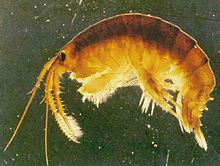
Amphipoda is an order of malacostracan crustaceans with no carapace and generally with laterally compressed bodies. Amphipods range in size from 1 to 340 millimetres and are mostly detritivores or scavengers. There are more than 9,900 amphipod species so far described. They are mostly marine animals, but are found in almost all aquatic environments. Some 1,900 species live in fresh water, and the order also includes the terrestrial sandhoppers such as Talitrus saltator.
Monoporeia affinis, formerly referred to as Pontoporeia affinis, is a small, yellowish benthic amphipod living in the Baltic Sea, the Arctic Sea and the lakes of the Nordic countries.

Gammaridea is one of the suborders of the order Amphipoda, comprising small, shrimp-like crustaceans. Until recently, in a traditional classification, it encompassed about 7,275 (92%) of the 7,900 species of amphipods described by then, in approximately 1,000 genera, divided among around 125 families. That concept of Gammaridea included almost all freshwater amphipods, while most of the members still were marine.
Bateidae is a family of amphipod crustaceans, comprising the single genus Batea, which in turn contains thirteen species:

Pardaliscidae is a family of amphipods, whose members typically inhabit the deepest parts of ocean basins. It contains the following genera:
Anisogammaridae is a family of small benthic amphipods, endemic to the northern part of the Pacific rim. The family contains the following genera:

Gammaridae is a family of amphipods. In North America they are included among the folk taxonomic category of "scuds", and otherwise gammarids is usually used as a common name.
Talorchestia is a genus of amphipod of the family Talitridae, containing the following species:

Gammarus is an amphipod crustacean genus in the family Gammaridae. It contains more than 200 described species, making it one of the most species-rich genera of crustaceans. Different species have different optimal conditions, particularly in terms of salinity, and different tolerances; Gammarus pulex, for instance, is a purely freshwater species, while Gammarus locusta is estuarine, only living where the salinity is greater than 25‰.

Niphargus is by far the largest genus of its family, the Niphargidae, and the largest of all freshwater amphipod genera.

Niphargidae is a family of amphipod crustaceans. Its distribution is in western Eurasia, and its members mainly live in subterranean freshwaters habitats. It contains the following genera:

Amaryllididae is a family of marine benthic amphipods found throughout the southern hemisphere. These smooth, laterally compressed amphipods can be distinguished by the accessory setal row of the mandible having a distal tuft. It was first described in 2002 by James K. Lowry and Helen E. Stoddart. It contains the following genera:
Pallaseidae is a family of amphipod crustaceans endemic to Lake Baikal. Some species are also found in the Angara River which flows out of Lake Baikal, and one species is distributed throughout Northern Palearctic. The composition of the family is a subject of discussion, with different sources listing either 9 genera and 58 species, or 8 genera and 20 species. They are benthic, nectobenthic or epibiotic.

Dikerogammarus villosus, also known as the killer shrimp, is a species of amphipod crustacean native to the Ponto-Caspian region of eastern Europe, but which has become invasive across the western part of the continent. In the areas it has invaded, it lives in a wide range of habitats and will prey on many other animals. It is fast-growing, reaching sexual maturity in 4–8 weeks. As it has moved through Europe, it threatens other species and has already displaced both native amphipods and previous invaders.
Chelicorophium is a genus of amphipod crustaceans, comprising the following species:

Alicellidae is a family of amphipod crustaceans, which live as scavengers in the deep sea, often in association with hydrothermal vents. The family includes the following genera:
Brandtia is a monotypic genus of amphipod in the Acanthogammaridae family, containing the species Brandtia latissima. Like other members of the family, it is endemic to Lake Baikal. This omnivore is found at depths of 1–65 m (3–213 ft) among stones. It is up to 1.9 cm (0.75 in) long.
Pseudamphithoides incurvaria is a species of amphipod crustacean in the family Ampithoidae. It is native to shallow water in the tropical western Atlantic Ocean where it creates a home for itself from fragments of the algae on which it feeds. This seaweed contains certain chemicals that are distasteful and protect it from predatory fish.

Eurythenes is a genus of marine amphipods in the family Eurytheneidae.
James Kenneth Lowry is a zoologist specialising in amphipods.








